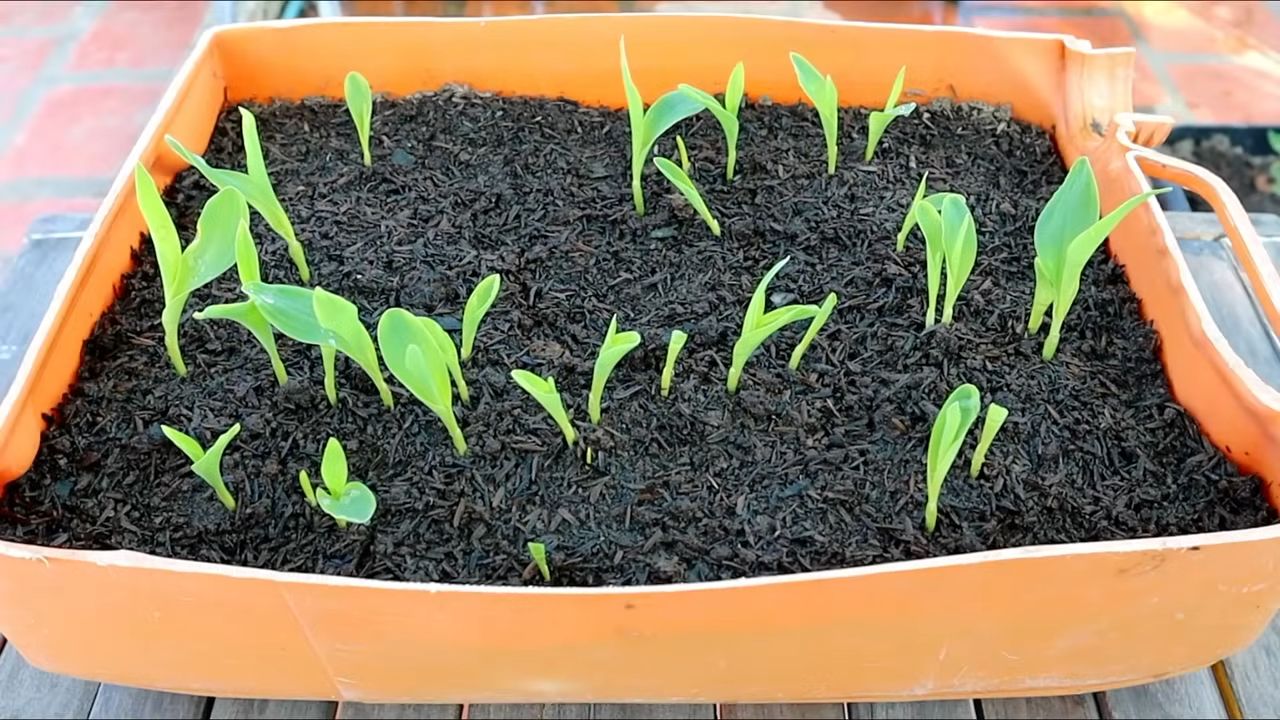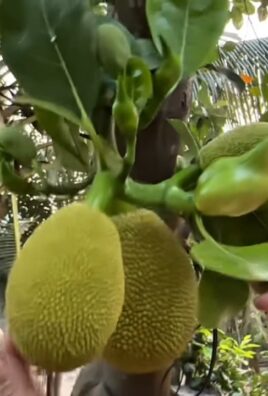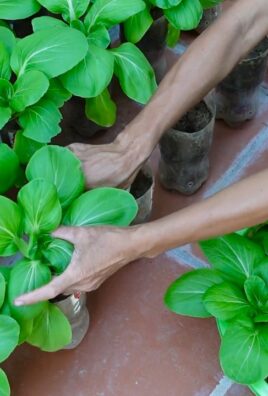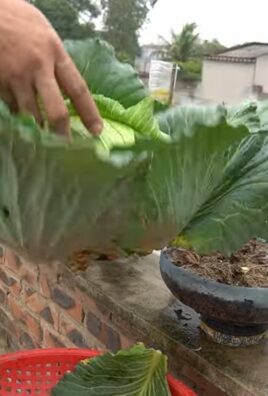Grow Corn Kitchen Garden: Imagine stepping outside your back door and harvesting fresh, sweet corn just minutes before dinner! Sounds like a dream, right? Well, it doesn’t have to be! For centuries, cultures around the world have cultivated corn, or maize, not just in vast fields, but also in smaller, more manageable spaces. From the ancient Aztecs who revered corn as a life-giving staple to modern-day gardeners seeking sustainable food sources, the desire to grow this versatile grain close to home has always been strong.
But let’s be honest, the thought of growing corn might seem intimidating, especially if you’re working with a limited area. That’s where this DIY guide comes in! I’m going to share some simple yet effective tricks and hacks to help you successfully grow corn kitchen garden, even if you only have a small backyard, patio, or balcony. Forget the sprawling farm; we’re bringing the cornfield to you, one pot (or raised bed!) at a time.
Why do you need these DIY tricks? Because fresh, homegrown corn tastes infinitely better than anything you can buy at the store. Plus, gardening is a fantastic way to de-stress, connect with nature, and teach your kids about where their food comes from. So, grab your gardening gloves, and let’s get started on this exciting journey to cultivate your very own corn patch right outside your kitchen door!

Growing Corn in Your Own Home Garden: A DIY Guide
Hello, garden friends! Have you ever dreamed of growing your own corn in the garden? It’s easier than you think, and the result is incredibly delicious! In this article, I’ll show you how you can easily do it yourself. Let’s dive into this exciting project together!
What You Need for Growing Corn
Before we get started, here is a list of the things you’ll need:
- Corn seeds: Choose a variety that is suitable for your region. There are many different types, from sweet corn to popcorn.
- Garden tools: A shovel, a rake, and possibly a dibber.
- Gardening gloves: To keep your hands clean.
- Compost or fertilizer: Corn is a heavy feeder and requires a lot of nutrients.
- Watering can or garden hose: For watering.
- Mulch material: Straw or wood chips to retain moisture in the soil and suppress weeds.
- Patience: Corn takes time to grow!
Preparing the Soil
A good start is half the battle! Proper soil preparation is crucial for a successful corn harvest.
- Location selection: Corn needs a lot of sun, at least 6-8 hours per day. So, choose a sunny spot in your garden.
- Soil cultivation: Loosen the soil with a shovel or digging fork. Remove stones and weeds. The soil should be well-draining.
- Soil improvement: Corn is a heavy feeder, which means it needs a lot of nutrients. Mix in plenty of compost or organic fertilizer. This provides a good foundation.
- Level the soil: Rake the soil smooth so it’s ready for sowing.
Sowing the Corn
Now comes the exciting part: sowing!
- Timing: Corn is sensitive to frost. So, wait until there is no more danger of frost. This is usually the case from mid-May onwards.
- Sowing method: Corn is sown directly outdoors. Use a dibber or your fingers to make small holes in the ground. The holes should be about 3-5 cm (1-2 inches) deep.
- Spacing: The distance between the holes should be about 20-30 cm (8-12 inches). The distance between rows should be about 60-75 cm (24-30 inches). Corn is best grown in blocks, as it requires wind pollination.
- Sowing: Place 2-3 corn seeds in each hole. This increases the likelihood that at least one seed will germinate.
- Covering: Cover the seeds with soil and press down lightly.
- Watering: Water the soil gently so the seeds are not washed away.
Caring for the Corn
The work isn’t over after sowing! Corn needs regular care to grow well.
- Watering: Corn requires a lot of water, especially during the flowering period. Water regularly, especially during dry spells. Make sure the soil does not dry out.
- Weed control: Regularly remove weeds that compete for nutrients. Mulching helps to suppress weeds.
- Fertilizing: Fertilize the corn during the growing season with an organic fertilizer or compost. A second application of fertilizer during the flowering period is recommended.
- Removing suckers: Remove the side shoots (suckers) that form at the base of the plant. These take unnecessary energy from the plant.
- Staking: In strong winds, it can be useful to support the corn plants so they don’t fall over.
Protecting Against Pests and Diseases
Even corn is not immune to pests and diseases. Here are some tips on how you can protect your plants:
- European corn borer: The European corn borer is a common pest. You can combat it with beneficial insects like parasitic wasps or with biological insecticides.
- Birds: Birds can eat the young seedlings. Protect the plants with a net or garden fleece.
- Fungal diseases: Fungal diseases can occur in wet weather. Ensure good ventilation and remove affected leaves.
Harvesting the Corn
The time has finally come: the harvest!
- Timing: The harvest time depends on the corn variety. Sweet corn is ready to harvest when the husks of the cobs are dry and brown and the kernels are plump and juicy. Popcorn is harvested only when the cobs are completely dry.
- Harvesting method: Carefully break the cobs off the plant.
- Storage: Sweet corn should be eaten as soon as possible after harvesting, as it quickly loses its sweetness. Popcorn can be stored for several months if it is dry.
Additional Tips and Tricks
Here are a few more tips that can help you with growing corn:
- Crop rotation: Don’t grow corn in the same spot every year. Crop rotation helps to keep the soil healthy and prevent diseases.
- Companion plants: Good companion plants for corn are beans, squash, and cucumbers. They support each other’s growth.
- Compost tea: Water your corn plants regularly with compost tea. This strengthens them and provides them with important nutrients.
- Experiment: Try out different corn varieties and find out which ones grow best in your garden.
Common Mistakes in Corn Cultivation
To save you from unnecessary mistakes, here is a list of the most common errors in growing corn:
- Sowing too early: Corn is sensitive to frost. Wait until there is no more danger of frost.
- Too little sun: Corn needs a lot of sun. Choose a sunny location.
- Too little water: Corn requires a lot of water, especially during the flowering period.
- Too little fertilizer: Corn is a heavy feeder and needs a lot of nutrients.
- Neglecting weed control: Weeds compete for nutrients.
- No support in strong winds: Corn plants can fall over in strong winds.
Why Growing Corn in Your Own Garden is So Worthwhile
Growing corn in your own garden is not only a rewarding experience but also offers many benefits:
- Fresh and delicious corn: Homegrown corn simply tastes better than store-bought corn.
- Sustainability: You know exactly what’s in your corn and can avoid using pesticides.
- Gardening as a hobby: Growing corn is a great way to spend time in the garden and relax.
- A learning experience: You learn a lot about plants and nature.
- Pride: It’s a great feeling to harvest and enjoy your own corn.
Conclusion
I hope this guide has encouraged you to grow your own corn in the garden. It’s an exciting project that, with a little patience and care, will lead to success. Happy gardening and a bountiful harvest! And remember: every plant you grow yourself is a small contribution to a more sustainable world.

Conclusion
So, there you have it! Growing your own corn, even in a limited space, is not only achievable but also incredibly rewarding. This DIY kitchen garden trick transforms the way you think about fresh produce and brings the joy of homegrown goodness right to your doorstep. Forget those bland, mass-produced ears of corn from the supermarket. Imagine sinking your teeth into sweet, juicy kernels that you nurtured from seed to harvest. The difference in flavor is simply unparalleled.
This method isn’t just about convenience; it’s about connecting with nature, understanding the growing process, and enjoying the fruits (or rather, vegetables!) of your labor. It’s a sustainable way to supplement your diet, reduce your carbon footprint, and add a touch of green to your living space. Plus, it’s a fantastic conversation starter!
But the benefits don’t stop there. This DIY approach to growing corn allows for incredible customization. Want to try a different variety? Go for it! Experiment with heirloom seeds for unique colors and flavors. Add companion plants like beans or squash to create a thriving mini-ecosystem. You can even adjust the container size and spacing to suit your specific needs and preferences.
Consider these variations to elevate your corn-growing experience:
* Succession Planting: Plant new seeds every few weeks to ensure a continuous harvest throughout the growing season.
* Vertical Gardening: If space is truly limited, explore vertical gardening options using trellises or stacked planters to maximize your yield.
* Companion Planting Power: Marigolds can help deter pests, while legumes like beans fix nitrogen in the soil, benefiting your corn plants.
* Composting Magic: Use homemade compost to enrich your soil and provide essential nutrients for healthy growth.
Ultimately, this DIY kitchen garden trick for growing corn is more than just a gardening project; it’s an investment in your health, your well-being, and your connection to the natural world. It’s a chance to learn, experiment, and enjoy the simple pleasure of growing your own food.
We wholeheartedly encourage you to give this a try. Don’t be intimidated if you’re a beginner. Corn is surprisingly resilient, and with a little care and attention, you’ll be amazed at what you can achieve. And most importantly, we want to hear about your experience! Share your photos, tips, and stories with us in the comments below. Let’s create a community of DIY corn growers and inspire others to embrace the joys of homegrown goodness. What are you waiting for? Grab some seeds, get your hands dirty, and start growing your own delicious corn today! This is the best way to get fresh **grow corn kitchen garden** produce.
Frequently Asked Questions (FAQ)
Q: What kind of corn is best for growing in containers?
A: While you can technically grow any type of corn in a container, dwarf or short-stalk varieties are generally recommended. These varieties are specifically bred to be more compact and manageable, making them ideal for smaller spaces. Some popular choices include ‘On Deck’, ‘Golden Bantam’, and ‘Trinity’. These varieties mature quickly and produce smaller ears, which are perfect for container gardening. Avoid taller varieties like ‘Silver Queen’ or ‘Country Gentleman’, as they require more space and may become unstable in containers.
Q: How much sunlight does my container corn need?
A: Corn is a sun-loving plant and requires at least 6-8 hours of direct sunlight per day to thrive. Choose a location for your containers that receives ample sunlight throughout the day. If you live in a particularly hot climate, you may want to provide some afternoon shade to prevent the plants from overheating. If you don’t have a sunny spot outdoors, you can supplement with grow lights.
Q: What type of soil should I use for growing corn in containers?
A: Use a well-draining potting mix that is rich in organic matter. Avoid using garden soil, as it can become compacted in containers and hinder drainage. A good potting mix will provide the necessary nutrients and aeration for healthy root growth. You can also amend your potting mix with compost or other organic materials to further improve its fertility.
Q: How often should I water my container corn?
A: Corn requires consistent moisture, especially during the critical stages of pollination and ear development. Water deeply whenever the top inch of soil feels dry to the touch. Avoid overwatering, as this can lead to root rot. The frequency of watering will depend on the weather conditions, the size of your containers, and the type of potting mix you are using. Check the soil moisture regularly and adjust your watering schedule accordingly.
Q: How do I pollinate my corn if I’m growing it in a container?
A: Corn is wind-pollinated, so if you’re growing it outdoors, the wind will usually take care of pollination. However, if you’re growing it indoors or in a sheltered location, you may need to hand-pollinate. To do this, gently shake the tassels (the male flowers at the top of the plant) to release pollen. Then, use a small brush or cotton swab to collect the pollen and transfer it to the silks (the female flowers that emerge from the developing ears). Repeat this process every day for several days to ensure successful pollination.
Q: When is the right time to harvest my corn?
A: The best time to harvest corn is when the silks have turned brown and dry, and the kernels are plump and milky. To test for ripeness, peel back a portion of the husk and puncture a kernel with your fingernail. If the liquid that comes out is milky, the corn is ready to harvest. If it’s clear, the corn needs more time to mature. If it’s thick and pasty, the corn is overripe.
Q: What kind of fertilizer should I use for my container corn?
A: Corn is a heavy feeder and requires regular fertilization to thrive. Use a balanced fertilizer with a ratio of 10-10-10 or 14-14-14. Apply the fertilizer according to the package directions, usually every 2-3 weeks. You can also supplement with organic fertilizers like compost tea or fish emulsion.
Q: How can I prevent pests and diseases from affecting my container corn?
A: Regularly inspect your plants for signs of pests or diseases. Common pests that affect corn include aphids, corn earworms, and spider mites. You can control these pests with insecticidal soap, neem oil, or by handpicking them off the plants. Common diseases that affect corn include rust and smut. You can prevent these diseases by providing good air circulation, avoiding overwatering, and using disease-resistant varieties.
Q: Can I grow corn in the same container year after year?
A: While it’s possible to reuse containers, it’s generally recommended to refresh the potting mix each year. This will help to replenish nutrients and prevent the buildup of pests and diseases. You can also amend the old potting mix with compost or other organic materials to improve its fertility.
Q: What are some good companion plants for corn in containers?
A: Companion planting can help to improve the health and yield of your corn plants. Some good companion plants for corn include beans, squash, marigolds, and herbs like basil and oregano. Beans fix nitrogen in the soil, which benefits the corn. Squash provides ground cover, which helps to suppress weeds and retain moisture. Marigolds deter pests, and herbs attract beneficial insects.





Leave a Comment